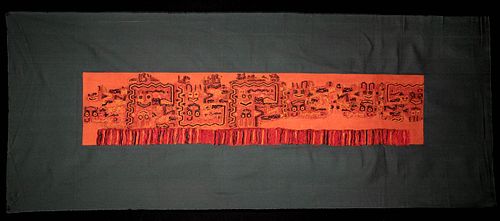Paracas Polychrome Textile Fragment - Flying Shamans
Lot 189
About Seller
Artemis Fine Arts
686 S Taylor Ave, Ste 106
Louisville, CO 80027
United States
Selling antiquities, ancient and ethnographic art online since 1993, Artemis Gallery specializes in Classical Antiquities (Egyptian, Greek, Roman, Near Eastern), Asian, Pre-Columbian, African / Tribal / Oceanographic art. Our extensive inventory includes pottery, stone, metal, wood, glass and textil...Read more
Categories
Estimate:
$4,000 - $6,000
Absentee vs Live bid
Two ways to bid:
- Leave a max absentee bid and the platform will bid on your behalf up to your maximum bid during the live auction.
- Bid live during the auction and your bids will be submitted real-time to the auctioneer.
Bid Increments
| Price | Bid Increment |
|---|---|
| $0 | $25 |
| $300 | $50 |
| $1,000 | $100 |
| $2,000 | $250 |
| $5,000 | $500 |
| $10,000 | $1,000 |
| $20,000 | $2,500 |
| $50,000 | $5,000 |
| $100,000 | $10,000 |
| $200,000 | $20,000 |
About Auction
By Artemis Fine Arts
Jun 10, 2021
Set Reminder
2021-06-10 10:00:00
2021-06-10 10:00:00
America/New_York
Bidsquare
Bidsquare : Exceptional Antiquities | Asian | Ethnographic
https://www.bidsquare.com/auctions/artemis-gallery/exceptional-antiquities-asian-ethnographic-7012
Museum-worthy examples of Egyptian, Greek, Roman, Viking, Near Eastern, Far East / Asian, Pre-Columbian, African / Tribal, Oceanic, Native American, Spanish Colonial, Russian, Fossils, Ancient Jewelry, Fine Art, so much more! Artemis Fine Arts info@artemisfinearts.com
Museum-worthy examples of Egyptian, Greek, Roman, Viking, Near Eastern, Far East / Asian, Pre-Columbian, African / Tribal, Oceanic, Native American, Spanish Colonial, Russian, Fossils, Ancient Jewelry, Fine Art, so much more! Artemis Fine Arts info@artemisfinearts.com
- Lot Description
Pre-Columbian, South Coast Peru, Paracas culture, ca. 500 to 300 BCE. A fabulous and sizable textile fragment composed of tightly woven camelid (alpaca or llama wool fibers) in hues of crimson, fuchsia, citrine, espresso, tangerine, and midnight-blue. The broad panel depicts several abstract flying shamans, each with a disembodied head and a sinuous body, with some boasting arching rabbit-like ears, and many surrounded by abstract feline figures. The shamanic heads feature diamond-shaped eyes, diagonal stripes on the cheeks indicative of scarification - or perhaps whiskers based on the feline motif - and thin lips curled into slight smiles. Above the dense figurative display is a register of fringe in red, yellow, and dark-blue hues. A fabulous and expressive example of textile artistry from the ancient Paracas! Mounted atop a museum-quality display fabric. Size (textile): 46.1" L x 9.7" W (117.1 cm x 24.6 cm); size (display fabric): 65.5" L x 26.5" W (166.4 cm x 67.3 cm).
Little is known about the Paracas people, and what little we do know comes from a 1920s archaeological excavation of the Paracas Cavernas, shaft tombs containing multiple burials, many of which contained ceramic vessels, probably for holding offerings or provisioning the dead in the afterlife. The iconography of the Paracas people is linear and stylistic, based on formal figures whose species, when zoomorphic, often cannot be identified. Motifs on their textiles mirror those of their ceramics that they used to wrap their dead and probably represent gods or mythical figures of power.
Provenance: private Hawaii, USA collection; ex-private Hans Juergen Westermann collection, Germany, 1950 to 1960s
All items legal to buy/sell under U.S. Statute covering cultural patrimony Code 2600, CHAPTER 14, and are guaranteed to be as described or your money back.
A Certificate of Authenticity will accompany all winning bids.
We ship worldwide and handle all shipping in-house for your convenience.
#148285Figurative fragment and fringe are sewn atop a modern orange-hued fabric panel for stability. Losses to some interior and peripheral areas as shown. Minor loosening to some interior and peripheral fibers, and light creasing. Iconography and original coloration are still visible.Condition
- Shipping Info
-
All shipping is handled in-house for your convenience. Your invoice from Artemis Gallery will include shipping calculation instructions. If in doubt, please inquire BEFORE bidding for estimated shipping costs for individual items.
-
- Buyer's Premium



 EUR
EUR CAD
CAD AUD
AUD GBP
GBP MXN
MXN HKD
HKD CNY
CNY MYR
MYR SEK
SEK SGD
SGD CHF
CHF THB
THB













